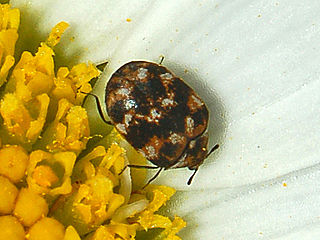
The varied carpet beetle is a 3 mm-long beetle belonging to the family Dermestidae, positioned in subgenus Nathrenus. They are a common species, often considered a pest of domestic houses and, particularly, natural history museums, where the larvae may damage natural fibers and can damage carpets, furniture, clothing, and insect collections. A. verbasci was also the first insect to be shown to have an annual behavioral rhythm and to date remains a classic example of circannual cycles in animals.
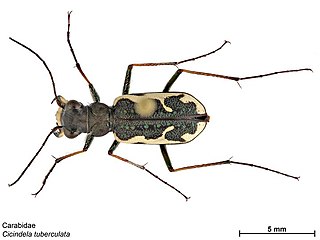
Neocicindela tuberculata is a species of tiger beetle in the family Cicindelidae, endemic to New Zealand. Its common names include common tiger beetle, moeone, and papapa, and in its larval stage penny doctor, butcher boy, kapuku, kui, kurikuri, moeone, and muremure. Neocicindela tuberculata was the first carabid beetle described from New Zealand. The species can run as fast as 5 miles per hour and are considered to be the fastest running beetles. Adult species prefer clay banks in summer and are good predators when in comes to insects.

Callipogon relictus is a species of longhorn beetle which is mostly found in Korea, but also in China and southern part of Russian Far East. It inhabits mixed and deciduous forests. The population of Callipogon relictus is decreasing due to deforestation and uncontrolled collection, and therefore the species are listed in the Russian Red Book.

Lyctus carbonarius is a wood-boring beetle in the family Bostrichidae, commonly known as the southern lyctus beetle. It is a serious pest of hardwoods including ash, hickory, oak, maple and mahogany and can infest many products in the home including hardwood flooring and structural timbers, plywood, furniture, tool handles, picture frames, baskets and ladders. Timber can be infested in one location and then be transported large distances by ship, after which the beetles can emerge and spread the infestation to new areas.
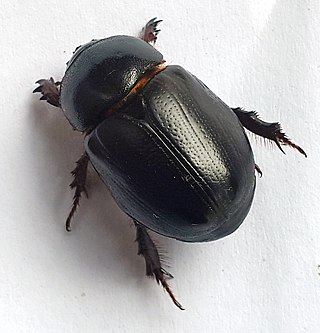
Heteronychus arator is a species of beetle in the subfamily Dynastinae. It is commonly called African black beetle or black lawn beetle. It is native to Africa and it is an introduced species in Australia, Norfolk Island and the North Island of New Zealand.
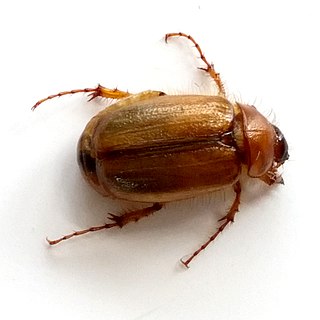
Costelytra giveni, commonly known as New Zealand grass grub, is a scarab beetle that is endemic to New Zealand and is a prevalent pasture pest.

Anisodactylus binotatus is a species of ground beetle native to Europe. It was discovered as being introduced to Canterbury, New Zealand in 1938. Anisodactylus binotatus is a species of Carabidae, also known as the ground beetle family. Although this species of beetle has no official recorded common names, literature from England refers to it as the common shortspur beetle.

Cerambyx welensii is a species of beetle in the family Cerambycidae.
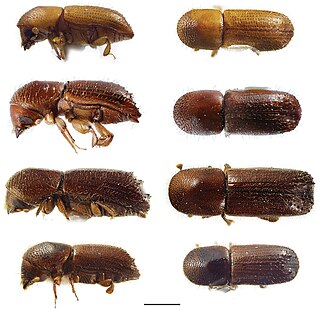
Xyleborus affinis, the sugarcane shot-hole borer, is a species of ambrosia beetle in the family Curculionidae. It is found on all continents with woodlands and is one of the most widespread ambrosia beetles internationally, primarily in areas with humid tropical climates like Florida. Like other ambrosia beetles, Xyleborus affinis is attracted to dead fallen logs in early stages of decay. Due to the presence of X. affinis on moist timber, this species is mistakenly believed to be the cause of tree death. However, there is insufficient evidence to support their presence as a causal factor. Rather, these beetles are believed to target and accelerate the decay process of trees that are already deteriorated and weak.

Lyperobius hudsoni is a flightless weevil found in alpine areas of Central Otago and Otago Lakes in the South Island of New Zealand.

Harmonia octomaculata is a species of ladybird of the family Coccinellidae. It is found throughout India, Pakistan, Nepal, Bangladesh, Sri Lanka, Micronesia, and Australia.
Adoretus versutus, commonly known as rose beetle, is a species of shining leaf chafer found in Afro-Oriental tropics.

Digitonthophagus bonasus, is a species of dung beetle found in India, Sri Lanka, Pakistan, Nepal, Myanmar, Thailand, Afghanistan, Vietnam and Cambodia.

Liatongus rhadamistus, or Scaptodera rhadamistus, is a species of dung beetle found in India, Sri Lanka, Laos and Thailand.

Cybister tripunctatus, is a species of predaceous diving beetle found in India, Andaman & Nicobar Islands, Sri Lanka, Afghanistan, Bangladesh, Myanmar, Nepal, Pakistan, Bhutan, China, Cyprus, Iran, Iraq, Japan, Kyrgyzstan, Mongolia, Russia, Syria, Tajikistan, Turkmenistan, Italy, Turkey, Uzbekistan and Europe.
Arixyleborus rugosipes, is a species of weevil native to India, Sri Lanka, Philippines, Malaysia, Borneo, Vietnam, Indonesia, and in Australia, Japan, Korea, New Zealand as an exotic species.
Synona obscura, is a species of lady beetle found in India and Sri Lanka.
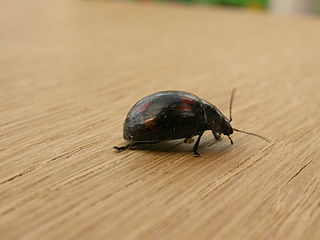
Paropsisterna beata, commonly known as the blessed leaf beetle, is a species of leaf beetle. It occurs in all states of Australia except Tasmania.
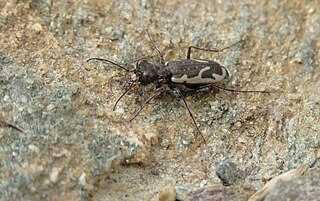
Neocicindela dunedensis, also known as the Dunedin tiger beetle, is a small species of tiger beetle in the genus Neocicindela endemic to New Zealand.
Anthrenus (Florilinus) kompantzevi is a little known species of carpet beetle in the family Dermestidae native to Kyrgyzstan. Species have been noted from southwest part of Kyrgyzstan to the Kyrgyz Ala-Too mountain range near canyons of Kara Balta river.
















